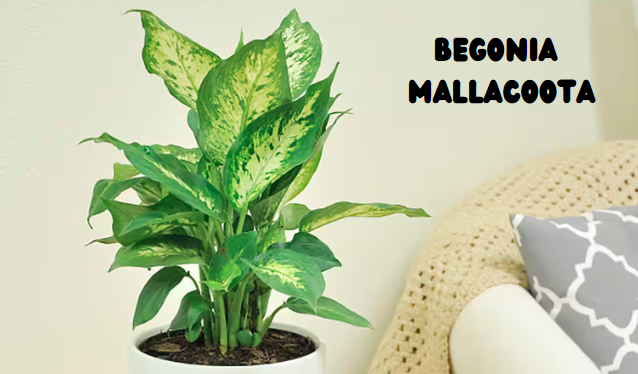Begonias are cherished by plant enthusiasts worldwide for their stunning variety and easy adaptability to indoor environments. One of the standout species is the Begonia Mallacoota. Known for its striking appearance and relatively simple care requirements, it has become a popular choice among both novice and seasoned indoor gardeners in the USA.
In this comprehensive article, we will delve deep into everything you need to know about Begonia Mallacoota—its origins, characteristics, care tips, and why it’s such a great addition to your indoor garden.
What is Begonia Mallacoota?
Begonia Mallacoota is a member of the large Begoniaceae family, a genus that includes over 1,800 species. This species is particularly known for its attractive foliage, which is usually a lush, velvety green with hints of reddish or purplish hues. The plant also occasionally produces delicate flowers, although it is primarily grown for its ornamental leaves.
Key Characteristics of Begonia Mallacoota:
- Foliage: The leaves of Begonia Mallacoota are large, asymmetrical, and typically display a unique combination of green and reddish tones. The texture of the leaves is slightly velvety, giving the plant an elegant appearance.
- Growth Habit: This plant is compact, making it ideal for smaller indoor spaces. It thrives well in containers and hanging baskets.
- Flowers: While not the primary attraction, Begonia Mallacoota can produce small clusters of pale pink or white flowers under the right conditions.
Natural Habitat
The Begonia Mallacoota is native to tropical and subtropical regions, where it thrives in moist, shaded areas. This natural preference for low-light environments makes it ideal for indoor gardening, where direct sunlight is often scarce.
Why Choose Begonia Mallacoota for Indoor Gardening?
Indoor gardeners in the USA are increasingly turning to Begonia Mallacoota for several compelling reasons. Here are some of the key benefits that set this begonia species apart:
1. Low Maintenance
Unlike many other houseplants that require precise conditions, Begonia Mallacoota is relatively easy to care for. It can tolerate a range of indoor conditions, including low light and occasional neglect. This makes it an excellent option for beginners.
2. Air-Purifying Qualities
Like many other indoor plants, Begonia Mallacoota contributes to improved indoor air quality. Its leaves help filter toxins from the air, creating a healthier living environment.
3. Aesthetic Appeal
The plant’s lush foliage adds an instant touch of elegance to any indoor space. Whether placed in a corner, on a shelf, or in a hanging basket, Begonia Mallacoota elevates the aesthetic of a room with its rich colors and unique leaf patterns.
4. Space-Saving Growth Habit
Thanks to its compact growth habit, Begonia Mallacoota is perfect for small apartments or rooms with limited space. Unlike larger houseplants, it won’t overwhelm your living area, making it an ideal addition for those looking to maximize greenery in smaller homes.
How to Care for Begonia Mallacoota
Proper care is key to keeping your Begonia Mallacoota healthy and vibrant. While the plant is forgiving, it thrives when given the right conditions. Here’s an in-depth look at the optimal care routine for this begonia species:
1. Light Requirements
While some begonia species require ample sunlight, Begonia Mallacoota prefers indirect or filtered light. Direct sunlight can cause its delicate leaves to scorch or fade. It thrives best when placed near a window that receives morning or late afternoon sunlight but is shielded from harsh midday rays.
2. Watering
This plant requires consistent watering, but be cautious not to overwater. The soil should be kept moist but not soggy. Water your Begonia Mallacoota when the top inch of soil feels dry to the touch. It’s also crucial to ensure proper drainage to prevent root rot, which is common in begonias if left sitting in waterlogged soil.
3. Humidity
Begonia Mallacoota thrives in environments with higher humidity levels. In drier climates, particularly in the USA during winter, you may need to mist the plant regularly or place it near a humidifier. You can also place the pot on a tray of pebbles and water to help maintain humidity.
4. Soil Type
This plant prefers a well-draining, slightly acidic soil mix. A mixture of peat moss, perlite, and potting soil will provide the right balance of moisture retention and drainage. Avoid using heavy garden soil, which can become compacted and hold too much water.
5. Fertilization
Feed your Begonia Mallacoota every 4-6 weeks during the growing season (spring and summer) with a balanced, water-soluble fertilizer. Dilute the fertilizer to half strength to avoid burning the plant’s roots. During the fall and winter, reduce feeding as the plant enters a dormant period.
6. Pruning
Occasional pruning can help keep your Begonia Mallacoota in shape and encourage bushier growth. Remove any yellowing or damaged leaves to maintain the plant’s health and appearance.
7. Repotting
Every 1-2 years, you may need to repot your Begonia Mallacoota as it outgrows its container. Choose a pot that is one size larger, and refresh the soil during the repotting process to give the plant a fresh environment for continued growth.
Common Problems and Solutions
Like any plant, Begonia Mallacoota may occasionally face challenges. However, most problems can be easily resolved with proper care.
1. Yellowing Leaves
If your Begonia Mallacoota‘s leaves start to yellow, this is usually a sign of overwatering. Ensure the soil is allowed to dry out slightly between waterings, and check that the pot has adequate drainage.
2. Leaf Browning
Browning at the edges of the leaves is often a result of low humidity. Increase the humidity around your plant by misting it regularly or using a humidifier.
3. Powdery Mildew
Begonias, including Begonia Mallacoota, are susceptible to powdery mildew—a fungal disease that appears as a white, powdery substance on the leaves. To prevent this, avoid getting the leaves wet and ensure proper air circulation around the plant.
The Role of Begonia Mallacoota in Interior Design
Indoor plants have a transformative effect on home décor, and Begonia Mallacoota is no exception. Its rich colors and striking leaf patterns make it a perfect statement plant in modern interior design. Here’s how you can integrate this beautiful plant into your living space:
1. Minimalist Spaces
For minimalist or Scandinavian-style homes, Begonia Mallacoota adds a pop of color and texture without overwhelming the simplicity of the design. Place it in a sleek, neutral-colored planter for a sophisticated look.
2. Bohemian Vibes
If your style leans toward the bohemian or eclectic, grouping Begonia Mallacoota with other indoor plants can create a lush, jungle-like atmosphere. Use decorative pots with intricate designs to add to the visual appeal.
3. Compact Living Spaces
Thanks to its size, Begonia Mallacoota is a perfect addition to small apartments or rooms with limited space. It can thrive on a windowsill, a corner shelf, or even in a hanging planter, making it highly versatile for any layout.
Benefits of Growing Begonia Mallacoota Indoors
Aside from its beauty, Begonia Mallacoota offers various practical benefits to indoor gardeners in the USA. These include:
1. Air Quality Improvement
Like many houseplants, Begonia Mallacoota helps to filter toxins from the air, such as formaldehyde, benzene, and other harmful pollutants. This creates a healthier indoor environment, particularly in urban areas where air quality may be compromised.
2. Mood Booster
Numerous studies have shown that indoor plants can help reduce stress, increase focus, and improve overall mood. The sight of a vibrant, healthy Begonia Mallacoota can be a simple but effective way to enhance your well-being.
FAQs About Begonia Mallacoota
1. How often should I water my Begonia Mallacoota?
Water your Begonia Mallacoota when the top inch of soil feels dry to the touch. Ensure the pot has proper drainage to prevent waterlogging.
2. Does Begonia Mallacoota need direct sunlight?
No, Begonia Mallacoota prefers indirect or filtered light. Direct sunlight can scorch its leaves.
3. What should I do if my Begonia Mallacoota’s leaves start to yellow?
Yellowing leaves are usually a sign of overwatering. Adjust your watering routine and ensure the soil drains well.
4. How do I increase humidity for my Begonia Mallacoota?
You can mist the plant regularly, place a humidifier nearby, or set the pot on a tray filled with pebbles and water.
5. When should I repot my Begonia Mallacoota?
Repot your Begonia Mallacoota every 1-2 years, or when it becomes root-bound. Choose a pot one size larger and refresh the soil during the repotting process.
Conclusion: Elevate Your Indoor Garden with Begonia Mallacoota
Begonia Mallacoota is a fantastic option for anyone looking to add a touch of elegance and color to their indoor garden. Its relatively low maintenance needs, combined with its aesthetic appeal, make it a favorite among indoor gardeners in the USA. Whether you are new to gardening or an experienced plant lover, this species will reward you with vibrant foliage and minimal fuss.


No responses yet